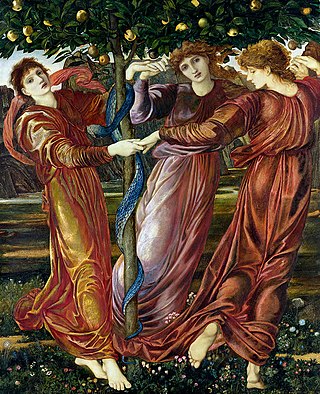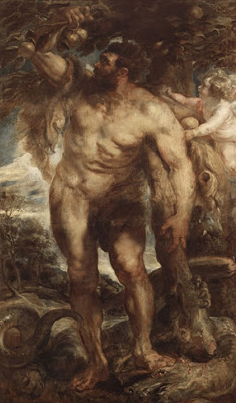
Hercules is the Roman equivalent of the Greek divine hero Heracles, son of Jupiter and the mortal Alcmena. In classical mythology, Hercules is famous for his strength and for his numerous far-ranging adventures.

The Pillars of Hercules are the promontories that flank the entrance to the Strait of Gibraltar. The northern Pillar, Calpe Mons, is the Rock of Gibraltar. A corresponding North African peak not being predominant, the identity of the southern Pillar, Abila Mons, has been disputed throughout history, with the two most likely candidates being Monte Hacho in Ceuta and Jebel Musa in Morocco. The term was applied in antiquity: Pliny the Elder included the Pillars of Hercules in his Naturalis historia.

In Greek mythology, the Hesperides are the nymphs of evening and golden light of sunsets, who were the "Daughters of the Evening" or "Nymphs of the West". They were also called the Atlantides from their reputed father, Atlas.

Frederic Leighton, 1st Baron Leighton,, known as Sir Frederic Leighton between 1878 and 1896, was a British Victorian painter, draughtsman, and sculptor. His works depicted historical, biblical, and classical subject matter in an academic style. His paintings were enormously popular and expensive, during his lifetime, but fell out of critical favour for many decades in the early 20th century.

The Farnese Hercules is an ancient statue of Hercules, probably an enlarged copy made in the early third century AD and signed by Glykon, who is otherwise unknown; he was an Athenian but he may have worked in Rome. Like many other Ancient Roman sculptures it is a copy or version of a much older Greek original that was well known, in this case a bronze by Lysippos that would have been made in the fourth century BC. This original survived for over 1500 years until it was melted down by Crusaders in 1205 during the Sack of Constantinople. The enlarged copy was made for the Baths of Caracalla in Rome, where the statue was recovered in 1546, and is now in the Museo Archeologico Nazionale in Naples. The heroically-scaled Hercules is one of the most famous sculptures of antiquity, and has fixed the image of the mythic hero in the European imagination.

The Villa d'Este is a 16th-century villa in Tivoli, near Rome, famous for its terraced hillside Italian Renaissance garden and especially for its profusion of fountains. It is now an Italian state museum, and is listed as a UNESCO World Heritage Site.

Larache is a city in northwestern Morocco. It is on the Moroccan coast, where the Loukkos River meets the Atlantic Ocean. Larache is one of the most important cities of the Tanger-Tetouan-Al Hoceima region.

The golden apple is an element that appears in various national and ethnic folk legends or fairy tales. Recurring themes depict a hero retrieving the golden apples hidden or stolen by a monstrous antagonist. Gold apples also appear on the Silver Branch of the Otherworld in Irish mythology.

Hercules of the Forum Boarium is one of two gilded bronze statues of Hercules found on the site of the Forum Boarium of ancient Rome. The two statues were both placed in the Palazzo Dei Convervatori for safe keeping in 1950 and remain there today. The Hercules of Forum Boarium was likely to have been a cult image of Temple of Hercules that stood by the ancient cattle market.
Giovanni BaptistaFerrari, was an Italian Jesuit, orientalist, university teacher and botanist. Linguistically highly gifted and an able scientist, at 21 years of age Ferrari knew a good deal of Hebrew and spoke and wrote excellent Greek and Latin. He became a professor of Hebrew and Rhetoric at the Jesuit College in Rome and in 1622 edited a Syriac-Latin dictionary.

The Villa di Castello, near the hills bordering Florence, Tuscany, central Italy, was the country residence of Cosimo I de' Medici, Grand Duke of Tuscany (1519-1574). The gardens, filled with fountains, statuary, and a grotto, became famous throughout Europe. The villa also housed some of the great art treasures of Florence, including Sandro Botticelli's Renaissance masterpieces The Birth of Venus and Primavera. The gardens of the Villa had a profound influence upon the design of the Italian Renaissance garden and the later French formal garden.

The Jardin Atlantique is a public park and garden located in the 15th arrondissement of Paris, on the roof that covers the tracks and platforms of the Gare Montparnasse railway station. It has an area of 3.4 hectares. It was created by the landscape architects Brun, Penna and Schnitzler, and opened in 1994.
The Herculean Sarcophagus of Genzano is a Roman sarcophagus from Genzano, which is in store at the British Museum. It features the Twelve Labours of Hercules. It has been dated to about AD 150–180. It is 221 cm long, 76 cm high and 91.5 cm wide.

Atlántida (Atlantis) is an opera in a prologue and three parts, by Manuel de Falla, based on the Catalan poem L'Atlàntida by Jacint Verdaguer. Falla worked on the score for twenty years but had not completed it at his death in Argentina in 1946; his disciple Ernesto Halffter prepared the score for performance.

The so-called Pavellons Güell, or Güell Pavilions, is a complex of buildings in the neighborhood of Pedralbes, Barcelona, by the Catalan Modernist architect Antoni Gaudí, built between 1884 and 1887.

The Caves of Hercules is an archaeological cave complex located in Cape Spartel, Morocco.

Deianira Listens to Fame or Deianira delivering the fatal tunic to the Fury is a 1638 oil painting on canvas. It is now in the Sabauda Gallery in Turin. It is a pendant to another Rubens painting, Hercules in the Garden of the Hesperides. It shows Hercules' wife Deianira and another woman holding a tunic soaked in the blood of Nessus, which Deianira believed would make Hercules to be forever true to her but instead killed him.

The Graveyard of the Hesperides is a 2016 historical mystery crime novel by Lindsey Davis and the fourth book in the Flavia Albia Mysteries series. The novel stars Flavia Albia, the British-born adopted daughter of Marcus Didius Falco. Albia, a widow, works as a "delatrix" in ancient Rome, like Falco.

Hercules and Antaeus is a 1531 oil painting by German artist Hans Baldung. It was donated in 1892 by Edward Habich to the Gemäldegalerie Alte Meister (Kassel) in Germany, where it still hangs.

The Lady of Shalott is an oil painting by the English artist William Holman Hunt, made c. 1888–1905, and depicting a scene from Tennyson's 1833 poem, "The Lady of Shalott". The painting is held by the Wadsworth Atheneum, in Hartford, Connecticut. A smaller version is held by the Manchester Art Gallery.


















